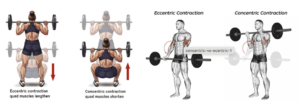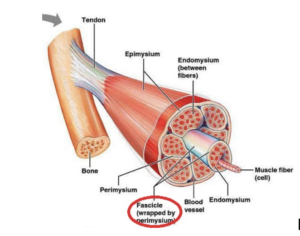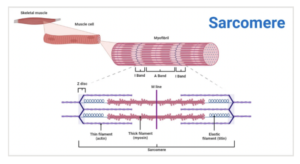Eccentric (ECC) muscle action: the active lengthening of muscle tissue against an external force or load.
Intro
In the world of weightlifting, and the world of strength training in general, coaches seem to flippantly throw around the word “eccentric” as a way to isolate or describe a specific part of an exercise or drill we want the athlete to focus on- without an understanding of what it means to actively create tension through the lengthening or stretch of a muscle. Most weightlifters seek to develop lean muscle, or at the very least maintain the muscle mass they have, for the benefit of their performance in the sport. But how many athletes, or coaches for that matter, understand that a lot of the magic of muscle building lies in the manipulation of eccentrics? (I use this word magic somewhat ironically because this is a sport science blog, but honestly there’s a lot of cool s**t going on.)
If you’ve ever taken an interest in bodybuilding, you’ve likely watched your fair share of Dr. Mike Israetel’s YouTube videos, who extols the benefit of “milking the eccentric” for muscle growth, while also being mindful of the stimulus to fatigue ratio(SFR) of a hypertrophy program based on a lot of time under tension (TUT). But really, there’s a strong argument to be made for integrating more eccentric-focused work within a weightlifting program–and far beyond that of just hypertrophy. Research has consistently shown its effectiveness in maximizing muscle size, strength, and power. For one, across a range of single-and multi-joint movements, skeletal muscle produces demonstrably more force during the eccentric portion of a lift as compared to the concentric portion (upwards of 20-60% more!) Additionally, some evidence shows preferential recruitment of fast twitch motor units with rapid eccentric muscle actions–so less a focus on time under tension but more athlete awareness around the velocity at which we lengthen the muscle. Anecdotally, when you observe your athlete complete a maximal vertical jump, how does he or she coordinate to produce maximal force? Looking at the depth and speed of his/her jerk dip for that matter will usually indicate your athlete’s predisposition toward relying more on explosiveness like Lydia Valentín (rapid eccentric loading), sheer strength like Lasha Talakhadze (slower eccentric loading), or a combination of the two.
The Why
So why do we care about this as weightlifters? Simply put, the sport relies on the athlete’s ability to produce power at very precise moments in time. So how does a focus on eccentric work contribute to one’s ability to produce more power?
Some specific adaptations to eccentric-focused training include:
- Increased muscle cross-sectional area
- Increased force output
- Increased fiber shortening velocities
- Greater anabolic signaling (due to greater satellite cell activation)
- Enhanced SSC (stretch shortening cycle) function
- Preferential recruitment of fast-twitch muscle fibers
Nerdy (but relevant!) Anatomy and Physiology
There’s a lot going on at the cellular level, so let’s break it down.
Titin, a structural protein that functions as a molecular spring, plays an especially important contractile role during eccentric muscle actions by increasing protein filament stiffness and force. Rapid eccentric muscle actions, in particular, rely on the neuromuscular advantages granted by muscle spindles. When a muscle is forcefully and rapidly lengthened (i.e., eccentric contraction), sensory receptors known as muscle spindles will commence “a stretch-reflex response to prevent over-lengthening and limit the possibility of injury. The engagement of these muscle spindles is thought to cause increased recruitment of motor units and/or an increased rate coding effect. An excitation of either or both of these neural responses would lead to a concurrent increase in concentric force output” (Walker, 2024).
In addition to these neuromuscular proprioceptors, we have a very specific sort of hypertrophy being stimulated through eccentric-focused training. Muscle fascicles are bundles of skeletal muscle fibers that run parallel to each other and are enclosed by a collagenous sheath known as the perimysium. Their very architecture determines the amount of force a muscle can generate, and research has shown increases specifically in fascicle length through eccentric-only as well as eccentric overload training. The increase in fascicle length would necessitate an increase in the number of sarcomeres, the smallest contractile unit of a muscle fiber, within a series. This increase of sarcomeres in-series then leads to two really positive outcomes for the athlete: 1) increased “absolute shortening velocity, and subsequently, power output” (Suchomel et al., 2019), as well as 2) helping to create more stiffness in the musculotendinous unit (MTC).
This in and of itself deserves a more thorough explanation because there’s a lot at play in creating tendon stiffness. We know isometric tension, a healthy dose of plyometrics, and methodical eccentric loading all play an important role in developing strong and stiff tendons. Where eccentric-focused training differs, however, is the preferential recruitment and hypertrophy of fast-twitch muscle fibers. Suchomel et al. (2019) have observed that “satellite cell activation, anabolic signaling, and EIMD [exercise induced muscle damage] following ECC-only actions have been found to be especially pronounced in fast twitch (i.e., type IIa and IIx) muscle fibers, which is suggestive of a fiber type specific response to ECC exercise, potentially stemming from a selective recruitment of these fibers.” It is the combination of increased sarcomeres and hypertrophy of fast-twitch muscle fibers that directly creates more stiffness in the MTU, which then creates the capacity for a more explosive athlete (stiffer MTU = more effective at rapidly transmitting force).
Implications for RFD
Finally there is eccentric velocity to consider: “logically, there is a markedly higher level of tension generated per active motor unit during maximal or heavy ECC actions, particularly when performed at a high velocity” (Suchomel et al., 2019). In fact, an abundance of studies support the use of relatively faster eccentric actions when attempting to develop and enhance muscular strength, power, and rate of force development (RFD). Stasinaki et al. (2019) observed statistically significant increases in vastus lateralis fascicle length with participants performing fast (<1.5 sec) eccentric-only squats at 70% of 1RM compared to participants that performed slow (4 sec) eccentric-only squats at 90% of 1RM. Though the latter group did see a significant increase in muscle thickness of the vastus lateralis (i.e., confirmation of the hypertrophic effects of time under tension-focused eccentric training), only the former group showed significant correlations between fascicle length changes and increased leg press RFD. Stasinaki et al. also postulated that “the lower eccentric velocity in the current study…together with an intense braking phase at the end of the downward movement might have induced an increase in fascicle length” (more on braking forces in a future blog post 😁).
Another study looking at the bench press confirmed the use of a faster eccentric movement for optimizing both power output and total work volume, even accounting for inter-repetition rest for both fast- and slow-eccentric groups. Pryor et al. (2011) noted that this observation mirrored previous research indicating “that fast eccentric phases increase the number of successful repetitions by using the stretch-shortening cycle (SSC). Augmented concentric contraction is often attributed to the storage and reuse of elastic energy from the series elastic component of the musculo-tendinous system. This increase in the rate of concentric contraction is observed especially in the initial phase of the contraction, when peak power is produced.” As mentioned in a previous blog post, the ability for a weightlifter to capitalize on the SSC is pretty crucial to his/her performance (ask any lifter that’s ever had to double-, triple-, or quadruple-bounce out of a clean). So if slow eccentrics allow us to build muscle and increase strength, and potentially drive neurological changes for newer athletes that just need to understand how to feel muscular tension; while faster eccentrics allow us to build the capacity for a higher RFD and therefore better utilization of the SSC, we should be incorporating some level of eccentric-focused training all the time, right?!
Future Discussion
Well, as always, it depends. Appropriate periodization of this stimulus is CRUCIAL. It’s incredibly important to be mindful of eccentric-emphasized resistance training DOMS (delayed onset muscle soreness) and its potentially considerable impact on neuromuscular function. Part of our work as coaches is understanding the SFR of specific exercise selection and how that may impact the individual athlete both acutely and chronically. Next in this series of blog posts focusing on eccentric training, we’ll take a look at current methods being reviewed by researchers, as well as some ideas for practical programming.
► TUT, flywheel inertial training, AEL (accentuated eccentric loading), and plyometrics ◀
Since all require different force absorption characteristics, consequently each method will yield different enhancements in hypertrophy, strength, and power (and therefore different levels of muscular and neurological fatigue → different considerations for programming → different iterations of “it depends” → ustedes ya saben).
✌🏽Angela Skarpelis
References
Pryor, R. R., Sforzo, G. A., & King, D. L. (2011). Optimizing power output by varying repetition tempo. Journal of Strength and Conditioning Research, 25(11), 3029–3034. https://doi.org/10.1519/jsc.0b013e31820f50cb
Suchomel, T. J., Wagle, J. P., Douglas, J., Taber, C. B., Harden, M., Haff, G. G., & Stone, M. H. (2019). Implementing eccentric resistance training—part 1: A brief review of existing methods. Journal of Functional Morphology and Kinesiology, 4(2), 38. https://doi.org/10.3390/jfmk4020038
Stasinaki, A.-N., Zaras, N., Methenitis, S., Bogdanis, G., & Terzis, G. (2019). Rate of force development and muscle architecture after fast and slow velocity eccentric training. Sports, 7(2), 41. https://doi.org/10.3390/sports7020041
Walker, O. (2024, April 29). Stretch-shortening cycle (SSC). Science for Sport. https://www.scienceforsport.com/stretch-shortening-cycle/#:~:text=The%20proprioceptors%20within%20the%20muscle,limit%20the%20possibility%20of%20injury




